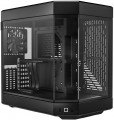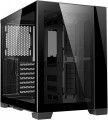Motherboard support
The type of motherboard for which the design is designed. This parameter is indicated by the form factor of the "motherboard", under which the case is designed. The options might be:
—
ATX. One of the most common types of motherboards today, the standard ATX size is 30.5x24.4 cm. It is used in both home and middle-class office PCs.
—
XL-ATX. The general name for several standards of motherboards, united, as the name implies, by rather large sizes and corresponding equipment. Specific values for these dimensions can vary from 324 to 345 mm long and 244 to 264 mm wide, depending on the manufacturer and model. Accordingly, when choosing such a case, it is worthwhile to separately clarify its compatibility with a specific motherboard.
—
E-ATX(Extended ATX). The largest type of motherboards, under which modern cases are made, has dimensions of 30.5x33 cm. It is usually used in high-performance systems that require numerous expansion slots.
— micro-ATX (m-ATX). The compact version of the ATX board has dimensions of 24.4x24.4 cm. The main scope of such boards is office systems that do not require high performance.
—
mini-ITX. One of the further reductions in the form factor of motherboards after
m-ATX assumes a board size of about 17x17 cm and one (most often) e
...xpansion slot. Also designed for compact systems that do not differ in performance.
— Thin mini-ITX. A modification of the mini-ITX described above, designed to reduce the thickness of the case (up to 25 mm), and the RAM sticks do not protrude upwards and lie on the "motherboard" parallel to the board itself (for more details, see "Form factor"). Like most compact designs, thin mini-ITX boards do not have high processing power.
Note that most cases allow the installation of smaller motherboards — for example, many E-ATX cases can be used with ATX motherboards. However, specific compatibility anyway should be clarified separately.PSU form factor
The form factor of the power supply that the chassis is designed to support. The form factor of the PSU is indicated by the type of motherboards for which the block was originally “sharpened”; however, many form factors are mutually compatible.
—
ATX(regular). Form factor designed for full-size cases, mainly Tower and Desktop types (see "Form Factor"). The motherboard is powered by a 24-pin (in older versions — 20-pin) connector; in addition, such power supplies usually provide an additional power plug for CPU (4-pin, 8-pin, and sometimes both at once).
—
FlexATX. The FlexATX form factor provides a miniature size of the motherboard (in terms of size and location of the mounting holes, such boards are compatible with microATX). Accordingly, the power supplies for them are compact in size and have increased efficiency characteristics. They are compatible with many miniature motherboards, including the mentioned microATX and mini-ITX, and the main connectors are the same as in ATX (minus the 20-pin version).
—
TFX. The abbreviation TFX comes from Thin Form Factor — i.e. "thin form factor". This is one of the varieties of compact power supplies used in miniature form factors systems; similar in compatibility to the microATX described above, and in terms of connectors — ATX.
—
SFX. Another type of po
...wer supply with reduced dimensions, used in compact systems (S — from "small", i.e. "small"). In terms of connectors, it is considered completely interchangeable with ATX, it fundamentally differs only in size.
— External. Cases that do not have space for an internal power supply at all and are designed to connect an external power supply unit. This design is found mainly among the smallest cases (in particular, for mini-ITX and thin mini-ITX motherboards). Note that in this case, not every case with an external power supply is meant, but only models that do not have built-in converters (see below) and are designed for motherboards with their own connector for an external power supply.
— External with converter. Enclosures designed for external power supplies (see above) and equipped with built-in converters. The converter outputs power from an external PSU to a number of "computer" connectors, in particular, a standard 24-pin motherboard power connector. Thus, in such a case, you can install a "motherboard" that has a traditional "ATX" power supply in 24-pin format.PSU max lenght
Possible length of the PSU that can be installed in the case.
Graphics card max lenght
The maximum length of a graphics card that can be installed in this case.
Modern mid-range and top-end video cards with high performance often differ in considerable length, which is why such a card can not fit into any case. So before collecting components, it is worth evaluating the length of the proposed graphics card and choosing a case in which it is guaranteed to fit. This forethought is useful anyway, but it's especially true if you're building a system that requires a powerful graphics adapter, such as a high-end gaming PC or 3D design workstation.
Fan max height
The highest cooler height allowed for this case.
In this case, we mean a cooler used to cool the processor — such a component is found in the vast majority of modern PCs. Height is measured relative to the motherboard.
PSU mount
The location of the power supply (or seat for the power supply) in the case.
The traditional option is the
top location of the PSU, this is a familiar and familiar option for many. However, heated air from other system components accumulates in the top of the case, reducing cooling efficiency. Cases
with a lower location of the PSU are deprived of this drawback, however, a lot of dust and other contaminants get into them if the system unit is installed on the floor. However, this difference becomes critical only when using high-performance systems with appropriate heat dissipation; for an ordinary household PC, the location of the power supply unit as a whole is not important.
Also note that in miniature cases like mini-Tower (see "Form factor"), the PSU installed on top can overlap part of the motherboard, which further worsens the cooling efficiency and makes it difficult to install large CPU coolers; however, it all depends on the layout of a particular case.
3.5" bays
The number of internal 3.5" form factor bays provided in the design of the case. Such bays, in accordance with the name, are intended for internal components, mainly hard drives and some SSD modules; to access them, the case must be disassembled.
Theoretically, the number of bays corresponds to the maximum number of drives that can be installed in the chassis. However, in fact, the best option is to install drives through a single slot to ensure efficient cooling. Accordingly, it is best to select a case in such a way that the number of internal 3.5" bays is twice the expected number of hard drives.
internal 2.5" compartments
The number
of internal 2.5" bays provided in the case design.
Such bays are mainly used for installing internal hard drives and SSD modules; The 2.5" form factor was originally created as "laptop" form factor, but recently it has been increasingly used in components for full-size PCs. At the same time, when evaluating the number of these bays, note that drives are recommended to be installed through a slot; so in Ideally, the number of bays should be twice the planned number of drives.
Also note that some cases use combined bays: initially they have a size of 3.5", but if desired, they can be converted to 2.5". These bays count towards both 3.5-inch and 2.5-inch slots. In fact, this means that the total number of available slots is not always equal to the sum of the number of both. For example, a case with 10 3.5" bays and 6 2.5" bays can have 4 combined bays, and the total number of slots in this case will not be 16, but only 12.
Expansion slots
The number of slots for expansion cards located on the rear panel of the case.
The expansion card itself (graphics card, sound card, TV tuner, etc.) is installed in a slot on the motherboard, and an external panel of such a card with inputs and outputs is attached to the hole on the back of the case. The more holes are provided in the case, the more expansion cards can be installed in it. Note that some boards can occupy two or even three holes at once; this is especially common in powerful video cards. On the other hand, you have to pay attention to the number of holes mainly if you are building a powerful high-performance system. For an ordinary household PC, in most cases, one opening is enough for a graphics card; and in many configurations, the openings on the rear panel are not used at all.

